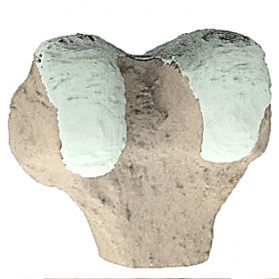
- Primary care
- General practice
- Femur anatomical model
- Ortho Baltic Implants

- Company
- Products
- Catalogs
- News & Trends
- Exhibitions
Femur anatomical model surgicaltraining
Add to favorites
Compare this product
Characteristics
- Area of the body
- femur
- Application
- surgical
- Procedure
- training
Description
Patient-specific 3D anatomical models are created from patients’ radiological examination (computed tomography and magnetic resonance tomography) images using special certified software. Anatomical models can be used in two forms: virtual anatomical models (for example, virtual models used in in pre-surgical planning software), or actual anatomical models which are materialized using additive manufacturing technologies.
Use of patient-specific anatomical models in clinical practice
Patient-specific anatomical models are used as a base for designing patient-specific implants and patient-specific surgical guides. They are used as a surgeon-manufacturer communication tool during pre-surgical planning, when the surgeon defines requirements for the design of a patient-specific implant and proceed to the validation of the design. More detailed information about the design of patient-specific implants and pre-surgical planning here.
Patient-specific anatomical models are also used as an assistive device when planning surgeries during which an implant is not applied. They allow assessing the topology of anatomical surfaces, the location and the ratio of pathological structures compared with healthy tissues. Using these models, surgeons plan intervention procedures, identify the potential challenges and anticipate their solutions.
When sterilized, patient-specific anatomical models are used during surgeries for the visualization of the surgical plan, as well as for training purposes.
Catalogs
No catalogs are available for this product.
See all of Ortho Baltic Implants‘s catalogsOther Ortho Baltic Implants products
Patient-specific Anatomical Models
*Prices are pre-tax. They exclude delivery charges and customs duties and do not include additional charges for installation or activation options. Prices are indicative only and may vary by country, with changes to the cost of raw materials and exchange rates.




